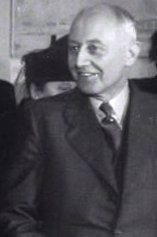Willem Marinus Dudok facts for kids
Quick facts for kids
Willem Marinus Dudok
|
|
|---|---|
 |
|
| Born | 6 July 1884 |
| Died | 6 April 1974 (aged 89) |
| Nationality | Dutch |
| Occupation | Architect |
| Awards | Royal Gold Medal (1935) AIA Gold Medal (1955) |
| Buildings | Hilversum Town Hall |
Willem Marinus Dudok (born July 6, 1884 – died April 6, 1974) was a famous Dutch architect who designed buildings in a modern style. He was born in Amsterdam, a big city in the Netherlands.
Dudok became the main architect for the town of Hilversum in 1928. He is most famous for designing the Hilversum Town Hall, which was finished in 1931. This building is made of brick and is very well-known. He didn't just design the building itself, but also everything inside, like the carpets, furniture, and even the mayor's special meeting hammer! He also designed and built about 75 houses, other public buildings, and even whole neighborhoods.
Contents
Dudok's Career and Style
Willem Dudok first started his career in the military. He studied civil engineering at a military school in Breda. This meant he learned how to design and build things like roads, bridges, and buildings. He even helped design military buildings.
He was inspired by other Dutch architects, like Hendrik Petrus Berlage. Dudok quickly became good at developing his own ideas. In 1913, he became an Assistant Director of Public Works in Leiden. Then, in 1915, he became the Director of Public Works in Hilversum. He was made Hilversum's official Municipal Architect in 1928.
In the same year, he was given the important job of making Hilversum bigger. This meant he had to design new housing areas, schools, swimming pools, and even parks and gardens.
Designing Hilversum Town Hall
Dudok's early designs in Hilversum were similar to the "Amsterdam School" style, which used a lot of brick and decorative elements. However, his most famous building, the Hilversum Town Hall, showed new influences. It had dramatic shapes, was not perfectly balanced (asymmetrical), and had roofs that hung over the edges. These ideas were clearly inspired by Frank Lloyd Wright and the "Chicago Prairie School" from the United States.
The Town Hall is seen as his best work. It successfully combines being a symbol for the city with being a useful office building. It also fits in with Hilversum's "garden-city" feel. Dudok was very much influenced by Ebenezer Howard and Raymond Unwin. These people were important in starting the "garden-city movement" in the United Kingdom. This movement focused on designing cities with lots of green spaces and a good quality of life.
Dudok kept designing modern buildings in Hilversum for many years, even into the 1960s. His work also influenced architects around the world. His school designs in Hilversum became especially famous among school builders in the Netherlands.
Other Important Buildings
Dudok also designed a branch of the De Bijenkorf department store in Rotterdam. This was a very impressive commercial building. It showed influences from the "Bauhaus" school of design, the "de Stijl" art movement, and the "streamlining" style popular in "Art Deco" and "Art Moderne" designs of the 1920s and 1930s. When it opened in 1930, about 70,000 people came to see it!
Sadly, parts of the store were destroyed in May 1940. This happened during the German bombing of Rotterdam when Nazi forces invaded the Netherlands. However, many photos, plans, and other materials about the building's design have survived. These helped create a Dutch documentary about Dudok's department store recently.
Awards and International Work
Willem Dudok received important awards for his work. He got the RIBA Gold Medal in 1935 and the AIA Gold Medal in 1955.
He also designed buildings in other countries. These include the Collège néerlandais (a Dutch college) in the Cité Universitaire in Paris, a cultural center in Baghdad, and a cinema in Calcutta. One of the buildings he designed in Rotterdam is now a cafe-restaurant named after him.
Dudok died in Hilversum at the age of 89.
Selected Works by Dudok
- City Hall, Hilversum, 1928–1931
- De Bijenkorf department store, Rotterdam, 1930 (destroyed during World War II)
- Monument on Afsluitdijk, The Netherlands, 1933
- Cité Universitaire, Collège néerlandais Paris, France, 1939
- City theatre, Utrecht, 1941
- Exxon Gas stations, The Netherlands, 1953
Images for kids
See also
 In Spanish: Willem Marinus Dudok para niños
In Spanish: Willem Marinus Dudok para niños





